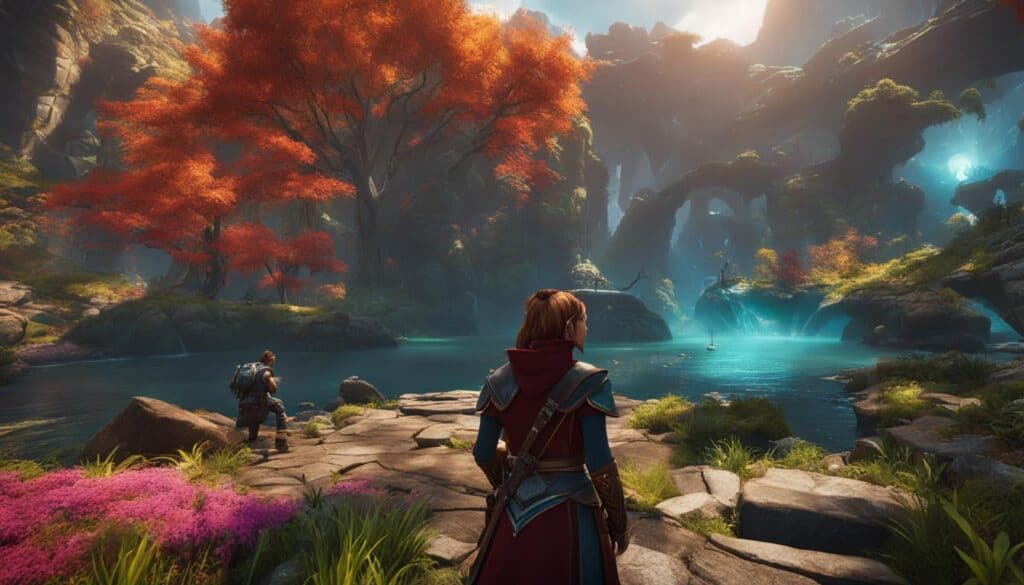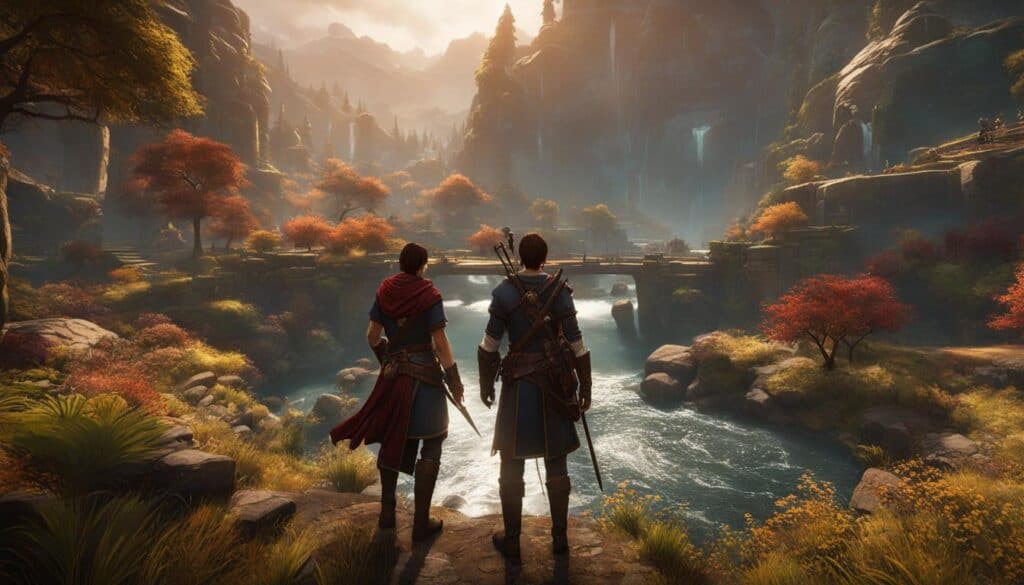Storytelling plays a crucial role in shaping the immersive and engaging experiences that video games offer. It is the driving force behind the narratives in games and has the power to captivate players and transport them to other worlds. The art of game storytelling involves crafting compelling characters, rich lore, and meaningful interactions that keep players invested in the virtual worlds they explore. According to research, video games with strong storytelling elements tend to attract a larger audience and have a higher player retention rate. Narrative design in games has evolved significantly over the years, with developers placing greater emphasis on creating meaningful player choices and branching storylines. Overall, the power of storytelling in video games cannot be underestimated, as it has the ability to enhance the gameplay experience and leave a lasting impact on players.
Key Takeaways:
- Storytelling is a crucial component in video games, shaping immersive experiences and captivating players.
- Strong storytelling elements attract a larger audience and enhance player retention.
- Narrative design in games has evolved, placing emphasis on meaningful player choices and branching storylines.
- Engaging storytelling can enhance the gameplay experience and leave a lasting impact on players.
- The power of storytelling in video games is essential for creating immersive and memorable experiences.
The Role of Narrative Design in Games

Narrative design is a fundamental aspect of game development, serving as the creative force behind captivating storylines and immersive experiences. It involves crafting compelling characters, designing meaningful interactions, and shaping the overall narrative arc of a game. Narrative design techniques are crucial in engaging players from the start and keeping them invested throughout the game.
One of the key elements of narrative design is the creation of memorable characters. Well-developed characters with believable motivations and personal growth are essential in driving the story forward and connecting players emotionally. Another important aspect is world-building, which involves constructing detailed and immersive game worlds filled with rich lore and history. These worlds provide a backdrop for the narrative and allow players to explore and discover new aspects of the story.
Interactive dialogue systems also play a significant role in narrative design. They enable players to make choices that impact the direction of the story, giving them a sense of agency and personalization. By allowing players to shape the outcome of the game through their decisions, narrative design creates a more engaging and dynamic experience.
Key Points:
- Narrative design is a crucial aspect of game development, shaping the overall story and player experience.
- Memorable characters, immersive world-building, and interactive dialogue systems are key elements of narrative design.
- Narrative design techniques engage players and allow them to shape the outcome of the game through their choices.
The Elements of Game Storytelling

Game storytelling is a multifaceted art that combines various elements to create immersive and captivating narratives. These elements work synergistically to transport players to new worlds, evoke emotions, and keep them engaged throughout their gaming experience.
The Power of Compelling Characters
Compelling characters are the heart and soul of any game’s story. They drive the narrative forward, create emotional connections with players, and make the story relatable and impactful. Well-developed characters have believable motivations, meaningful arcs, and unique personalities that resonate with players. As players invest in the journey of these characters, they become more engaged with the narrative and the game as a whole.
The Importance of Rich Game Worlds
A richly detailed game world is essential for effective storytelling. It provides a captivating backdrop for the narrative to unfold and allows players to immerse themselves in the game’s story. Through world-building, developers create lore, history, and environments that players can explore and interact with, deepening their engagement with the story. A well-crafted game world adds depth and authenticity to the narrative, making it more compelling and immersive.
Interactive Dialogue Systems and Player Choices
Interactive dialogue systems and player choices are integral to game storytelling. These elements give players agency and allow them to shape the outcome of the story through their decisions. Meaningful choices create a sense of ownership and investment in the narrative, as players feel that their actions have consequences. Interactive dialogue systems further enhance player engagement by providing opportunities for meaningful interactions with characters and exploring different dialogue options.
Overall, the elements of game storytelling intertwine to create a powerful and captivating experience for players. Compelling characters, rich game worlds, and interactive narrative mechanics work together to transport players to new realms of imagination and leave a lasting impact on their gaming journey.
The Impact of Game Storytelling on Player Engagement

Game storytelling plays a crucial role in capturing and maintaining player engagement. Well-crafted narratives have the power to evoke emotions, create immersive experiences, and keep players invested in the game. According to research, players who feel emotionally connected to the story are more likely to have a memorable and enjoyable gaming experience. This highlights the importance of storytelling in captivating players and enhancing their overall engagement.
One of the key aspects of game storytelling is the ability to create a sense of agency for players. When players feel that their choices matter and have an impact on the game’s story, they are more likely to stay engaged and invested in the gameplay experience. Meaningful player choices and branching storylines allow players to shape the outcome of the game, providing a personalized and interactive narrative experience.
Additionally, game storytelling contributes to the overall immersion of players in the virtual world. By creating compelling characters, intricate lore, and detailed game worlds, developers can transport players to other worlds and make them feel a part of the narrative. This sense of immersion further enhances player engagement and creates a deeper connection between the player and the game.
The Evolution of Storytelling in Video Games
Storytelling in video games has come a long way, evolving alongside the advancements in technology and the changing preferences of players. From simple narratives that served as context for gameplay to immersive and complex storylines, game storytelling has become an integral part of the gaming experience. As the industry grew, developers began to prioritize narrative design, resulting in the rise of story-driven video games.
Early video games often had linear narratives with limited player agency. However, with the advent of narrative design in games, developers started incorporating meaningful player choices and branching storylines into their narratives. This allowed players to shape the outcome of the game and increased their sense of immersion and engagement. With the combination of compelling narratives and interactive gameplay, story-driven video games have gained popularity among players who seek emotionally impactful and thought-provoking experiences.
Game storytelling has not only impacted individual game titles but has also shaped the entire video game industry. The demand for immersive narrative experiences has prompted developers to invest more resources into narrative design, resulting in games with rich and compelling stories. Furthermore, strong storytelling has attracted a wider audience, including individuals who may not typically consider themselves gamers. This diversification of the player base has contributed to the continued growth of the industry.
The future of game storytelling looks promising, with advancements in technology such as virtual reality and augmented reality offering new opportunities for immersive storytelling experiences. Additionally, artificial intelligence holds the potential to create more dynamic and personalized narratives, where the game adapts to player choices and behaviors. As game developers continue to push the boundaries of narrative design, players can expect even more captivating and interactive storytelling experiences in the years to come.
The Influence of Game Storytelling on the Industry

Game storytelling has had a profound influence on the video game industry as a whole. According to research, story-driven games have gained popularity among players, leading to an increase in demand for immersive narrative experiences. This has prompted developers to invest more resources into narrative design, resulting in games with rich and compelling stories. Strong storytelling in games also has the potential to attract a wider audience, including individuals who may not typically consider themselves gamers. This diversification of the player base has contributed to the continued growth of the industry.
The influence of game storytelling extends beyond individual game titles, shaping the direction of the industry and pushing boundaries in terms of storytelling techniques and innovative narrative design. As developers continue to create engaging narratives, the impact of game storytelling is expected to grow even further. The combination of compelling stories, interactive gameplay, and emotional connections has made video games a unique and powerful storytelling medium.
Furthermore, the success of story-driven games has inspired other forms of media, such as movies and television shows, to incorporate game-like storytelling elements. This cross-pollination of storytelling techniques has resulted in new and exciting experiences for audiences across different entertainment mediums. The influence of game storytelling is not limited to the gaming industry alone; it has the potential to shape and redefine storytelling in various forms of media.
Game Storytelling and Emotional Impact
Game storytelling has an immense ability to evoke a wide range of emotions in players, creating impactful and memorable experiences. Well-crafted narratives can elicit strong emotional responses, such as joy, sadness, fear, or surprise. These emotional connections enhance players’ engagement with the game and contribute to their overall enjoyment.
According to research, emotional impact plays a crucial role in player immersion and satisfaction. When players feel emotionally invested in the story and characters, they become more connected to the virtual world they are experiencing. This emotional connection can enhance the overall gameplay experience and draw players back for more.
“Storytelling is the beating heart of game design. It has the power to make players laugh, cry, and reflect on their own lives. It’s what elevates games from mere entertainment to a form of art that can deeply touch people.” – Game Designer
Game developers leverage storytelling techniques such as character development, plot twists, and immersive world-building to create narratives that resonate with players on an emotional level. By immersing players in compelling stories, developers can make the game more memorable and leave a lasting impact.
The Power of Emotional Engagement
Emotional engagement is a key factor in player retention and satisfaction. When players feel a deep connection with the game’s story and characters, they are more likely to stay engaged and invested in the gameplay experience. This emotional engagement can also lead to word-of-mouth recommendations and positive reviews, contributing to the success of the game.
- Emotionally impactful moments in games can create lasting memories for players. These moments can range from heartwarming interactions with characters to heartbreaking plot twists that leave players in shock.
- By harnessing the power of emotional storytelling, game developers can create experiences that resonate with players long after they have finished playing.
- Emotional impact can also enhance the replayability of games, as players may want to revisit the story and characters to experience those emotional moments again.
Overall, game storytelling has the ability to elicit powerful emotional responses and create immersive and memorable experiences for players. Through well-crafted narratives and engaging characters, game developers can transport players to new and unforgettable worlds, leaving a lasting impact that extends beyond the confines of the virtual realm.
The Future of Game Storytelling
The future of game storytelling holds immense promise as developers continue to innovate and explore new possibilities. Advancements in technology, such as virtual reality and augmented reality, have the potential to revolutionize storytelling in video games. With these immersive technologies, players can be fully immersed in virtual worlds, creating a more immersive and interactive narrative experience. Imagine exploring fantastical realms, engaging with characters, and making choices that have a tangible impact, all within a virtual environment that feels incredibly lifelike.
Furthermore, artificial intelligence (AI) has the potential to enhance storytelling in games. AI algorithms can analyze player behavior and adapt the narrative in real-time, creating dynamic and personalized storytelling experiences. This allows for a more tailored and immersive narrative, where players feel a deeper connection to the story and the characters.
“Advancements in technology, such as virtual reality and artificial intelligence, have the potential to revolutionize game storytelling, offering players more immersive and personalized experiences.”
As the industry continues to evolve, we can expect to see more experimentation with narrative structures and unconventional storytelling techniques. Developers are constantly pushing the boundaries of storytelling in video games, exploring new ways to engage players emotionally and intellectually. This could involve non-linear narratives with multiple branching paths, interactive storytelling mechanics that respond to player choices, or even collaborative storytelling experiences where players can create and share their own narratives.
The future of storytelling in video games is exciting and full of possibilities. With advancements in technology and innovative storytelling techniques, players can look forward to even more immersive, interactive, and emotionally impactful experiences in the years to come.
Game storytelling is a powerful medium that has the potential to transport players to new worlds, evoke strong emotions, and create lasting memories. It is the driving force behind the most captivating and engaging video game experiences. As the future of game storytelling unfolds, we can expect to see even more groundbreaking narratives, innovative gameplay mechanics, and immersive technologies that push the boundaries of what is possible in the world of gaming.
The Art of Crafting Game Narratives
Crafting game narratives is a complex and intricate process that requires careful planning and attention to detail. The art of storytelling in video games involves weaving a captivating narrative that immerses players in the game world and keeps them engaged throughout their journey. Game developers work closely with writers, designers, and other creatives to bring the story to life, ensuring that it aligns with the gameplay mechanics and overall vision of the game.
One important aspect of crafting game narratives is narrative structure. The story should have a clear beginning, middle, and end, with well-paced plot and character development. It’s essential to create compelling characters that players can connect with and root for, as they are the driving force behind the narrative. Effective use of storytelling techniques, such as foreshadowing, plot twists, and well-placed dialogue, can further enhance the immersive experience.
“Crafting game narratives is like writing a book in which the player becomes the protagonist. It’s about creating a world that players can explore and a story that they can shape through their actions and decisions.” – Game Developer
Playtesting and player feedback are crucial in refining and improving the storytelling elements of a game. It allows developers to identify areas that may need tweaking and ensure that the narrative resonates with players. Iterative storytelling ensures that the game narrative evolves and becomes more impactful over time, ultimately providing players with a memorable and immersive experience.
The Role of Narrative Designers
In the world of game development, narrative designers play a vital role in crafting game narratives. They are responsible for creating engaging storylines, designing meaningful player choices, and implementing branching paths that offer different outcomes based on player decisions. Narrative designers work closely with the development team to ensure that the narrative and gameplay are seamlessly integrated.
- Narrative Structure: Narrative designers establish the overall structure of the game’s story arc, ensuring that it is cohesive and engaging. They create a roadmap that guides players through the narrative, incorporating plot twists, character arcs, and key moments.
- Interactive Dialogue Systems: Narrative designers design interactive dialogue systems that allow players to engage with non-playable characters (NPCs) and make choices that impact the story. These systems give players a sense of agency and make them feel like active participants in the narrative.
- Player Choice and Consequence: Narrative designers create meaningful choices for players to make throughout the game. These choices can have consequences that affect the direction of the story, providing players with a personalized experience and a sense of ownership over the narrative.
The work of narrative designers is essential in crafting game narratives that resonate with players, leaving a lasting impact and creating memorable gaming experiences.
The Future of Game Narratives
As technology continues to advance, the future of game storytelling holds exciting possibilities. Virtual reality (VR) and augmented reality (AR) offer new avenues for immersive storytelling, allowing players to step into the game world like never before. The use of AI and machine learning can also enhance storytelling by creating dynamic narratives that adapt to player choices and behaviors.
Additionally, the evolution of game narratives extends beyond traditional video games. The rise of interactive storytelling in other forms of entertainment, such as interactive movies and virtual reality experiences, showcases the growing demand for immersive narratives.
Overall, the art of crafting game narratives is an ever-evolving process that continues to push the boundaries of storytelling in video games. As developers strive to create more immersive and engaging experiences, players can look forward to a future where game narratives provide even more depth, emotion, and interactivity.
The Connection Between Gameplay and Storytelling
The connection between gameplay and storytelling is a fundamental aspect of creating a cohesive and satisfying gaming experience. The interplay between these two elements enhances player engagement and immersion, making the game world more compelling and memorable.
When gameplay and storytelling are well-integrated, players feel a sense of agency and connection to the narrative. The actions they take in the game have meaning and impact, shaping the story and allowing for a more personalized experience. This connection between gameplay and storytelling is what sets video games apart as a unique storytelling medium.
For example, in a role-playing game (RPG), the player’s choices and actions directly influence the outcome of the story. The gameplay mechanics, such as character customization, skill development, and decision-making, are all interconnected with the narrative, creating a seamless experience where the player’s journey is driven by their own choices and actions.
“The interplay between gameplay and storytelling is what makes video games such a powerful medium for storytelling. It allows players to become active participants in the narrative, shaping the story through their own actions and decisions.” – Game Developer Magazine
The Benefits of a Strong Gameplay-Storytelling Connection
When gameplay and storytelling are synergistic, it enhances the overall gaming experience in several ways:
- Immersion: A strong gameplay-storytelling connection immerses players in the game world, making them feel like an integral part of the story.
- Investment: Players become emotionally invested in the narrative and characters when their actions and choices have consequences that directly impact the story.
- Retention: Games with a strong gameplay-storytelling connection have higher player retention rates, as players feel compelled to continue playing to uncover the next chapter of the story.
- Longevity: A strong gameplay-storytelling connection contributes to the longevity of a game, as players are more likely to revisit the game to experience different story outcomes or explore alternative paths.
The connection between gameplay and storytelling is a delicate balance that game developers strive to achieve. When done successfully, it creates a cohesive and immersive experience that resonates with players and elevates the impact of the narrative.
Exploring Different Genres of Story-Driven Games
Story-driven games come in various genres, each offering unique and captivating storytelling experiences. Whether you prefer adventure games, role-playing games (RPGs), or interactive drama games, there’s a genre out there to cater to your storytelling cravings. Adventure games are known for their immersive narratives, intricate puzzles, and rich character development. These games often focus on exploration and decision-making, allowing players to unravel deep mysteries and shape the outcome of the story.
RPGs, on the other hand, provide players with vast open worlds to explore and intricate narratives to uncover. These games often feature complex character customization, branching storylines, and meaningful player choices. RPGs allow players to fully immerse themselves in the game world and embark on epic quests, forging their own path and experiencing a story unique to their decisions.
Interactive drama games, also known as narrative-driven games, place a heavy emphasis on storytelling and character development. These games often feature cinematic cutscenes, branching dialogue options, and choices that impact the narrative’s direction. Interactive drama games aim to evoke strong emotional responses from players, immersing them in dramatic and thought-provoking narratives that leave a lasting impact.
It’s worth mentioning that while these genres excel in storytelling, other genres like action-adventure and stealth games also incorporate narrative elements into their gameplay. Although these games may prioritize gameplay mechanics, they still offer engaging stories and memorable characters.
Why Are Story-Driven Games Popular?
Story-driven games have gained a massive following due to their ability to transport players into immersive and captivating narratives. These games provide players with a unique form of entertainment that allows them to be part of the story, making decisions that shape the outcome. The combination of engaging gameplay mechanics and thoughtfully crafted narratives offers an incredible gaming experience that keeps players coming back for more.
Choosing the Right Story-Driven Game for You
When selecting a story-driven game, consider the genre and themes that interest you the most. If you enjoy solving puzzles and exploring mysterious worlds, adventure games might be your best bet. If you prefer deep character interactions and moral dilemmas, RPGs might be more up your alley. Additionally, reading reviews and watching gameplay trailers can give you a better idea of what to expect from a particular game’s storytelling elements.
No matter which genre you choose, story-driven games offer a unique and immersive experience that allows you to become the protagonist in your own narrative. So dive into the world of game storytelling and discover the power of narrative design in shaping unforgettable gaming experiences.
Conclusion
Game storytelling, narrative design in games, and story-driven video games play a vital role in providing immersive and engaging experiences for players. The art of game storytelling involves crafting compelling narratives, memorable characters, and meaningful interactions that transport players to other worlds. With research indicating that video games with strong storytelling elements attract a larger audience and have higher player retention rates, developers have placed greater emphasis on creating meaningful player choices and branching storylines.
The power of storytelling in video games cannot be underestimated. Compelling characters, rich lore, and interactive dialogue systems are essential elements that contribute to the success of game storytelling. These elements, combined with well-crafted storylines, enhance the gameplay experience and leave a lasting impact on players. Engaging narratives in video games have a significant influence on player engagement, driving motivation, creating emotional connections, and keeping players invested in the game’s narrative.
Storytelling in video games has evolved significantly, reflecting advancements in technology and changing player preferences. The rise of story-driven video games has led to the prioritization of narrative and character development, resulting in diverse storytelling experiences across various genres. As the industry continues to grow, game storytelling shapes the direction of the video game industry, attracting a wider audience and pushing boundaries in terms of storytelling techniques and innovative narrative design. The future of game storytelling holds exciting possibilities, with advancements in technology, such as virtual reality and augmented reality, and the potential for artificial intelligence to create even more immersive and interactive narratives for players to explore.
FAQ
How does storytelling impact video games?
Storytelling plays a crucial role in shaping immersive and engaging experiences in video games. It drives the narratives, captivates players, and transports them to other worlds.
Do games with strong storytelling attract more players?
Yes, research shows that video games with strong storytelling elements tend to attract a larger audience and have a higher player retention rate.
How has narrative design in games evolved?
Over the years, narrative design in games has evolved to focus on creating meaningful player choices and branching storylines, allowing for greater player agency and personalization.
What elements are important in game storytelling?
Game storytelling involves crafting compelling characters, rich lore, and meaningful interactions. It also includes the creation of immersive game worlds and interactive dialogue systems.
How does game storytelling impact player engagement?
Engaging narratives enhance player engagement by creating emotional connections, offering a sense of agency, and captivating players’ attention.
How has storytelling in video games evolved over time?
Storytelling in video games has evolved from simple narratives to more complex and sophisticated techniques, with a focus on character development and player choice.
How has game storytelling influenced the video game industry?
Game storytelling has led to the popularity of story-driven games, attracting a wider audience and pushing the boundaries of storytelling in video games.
Can game storytelling evoke emotions in players?
Yes, well-crafted narratives in video games can elicit strong emotional responses from players, enhancing their engagement and enjoyment.
What does the future hold for game storytelling?
The future of game storytelling holds exciting possibilities, including advancements in technology like virtual reality and augmented reality, as well as the potential for artificial intelligence to create more dynamic and personalized narratives.
How are game narratives crafted?
Crafting game narratives requires careful planning, attention to detail, and collaboration between developers, writers, and creatives. Playtesting and player feedback are also essential in refining the storytelling elements.
How does gameplay and storytelling connect in video games?
Gameplay and storytelling should complement each other in video games, with the mechanics reflecting the story and allowing players to engage with the narrative in a meaningful way.
What genres are commonly associated with story-driven games?
Adventure games, role-playing games (RPGs), and interactive drama games often prioritize narrative and character development. Other genres like action-adventure and stealth games also incorporate storytelling elements.
 Online Gaming Circuit
Online Gaming Circuit




